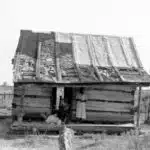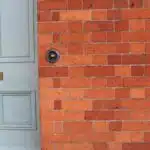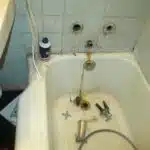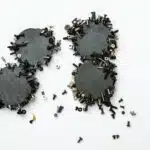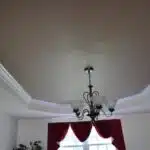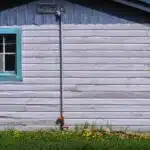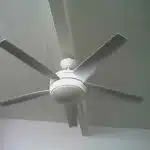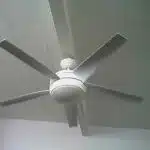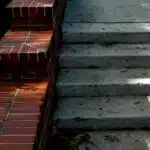A leaking ceiling can be a frustrating and potentially costly problem for homeowners. While the cause of a leak may not always be immediately apparent, it is important to address any leaks as soon as possible in order to prevent further damage to your home’s structure and contents. In this article, we will provide you with a step-by-step guide on how to troubleshoot and repair a leaking ceiling.
First, we will discuss how to identify the source of the leak. This can sometimes be a challenging task, but by following a few simple steps, you can usually pinpoint the location of the problem. Once you have located the source of the leak, we will walk you through the process of repairing it. Whether it is a minor issue that can be fixed with some caulk or sealant, or a more significant problem that requires professional help, we will provide you with all of the information you need to get your ceiling back in good shape. By following our advice and taking prompt action when necessary, you can save yourself time, money, and hassle in dealing with a leaking ceiling.
Understanding The Importance Of Addressing A Leaking Ceiling
Addressing a leaking ceiling is crucial for any homeowner. Not only can it cause structural damage to your home, but it can also lead to the growth of mold and mildew, which can be hazardous to your health. Therefore, it is essential to understand the importance of addressing this issue as soon as possible.
The first step in preventing a leaking ceiling is to regularly inspect your roof for any signs of wear and tear. This includes checking for loose or missing shingles, cracks in the flashing, and damaged gutters. By identifying these issues early on, you can prevent them from turning into more significant problems that could result in a leaky ceiling.
If you do notice water stains or damp spots on your ceiling, do not ignore them. Even if they appear small at first glance, they could be an indication of a larger issue that needs to be addressed immediately. The longer you wait to repair a leaky ceiling, the more damage it can cause to your home and personal belongings.
Once you understand the importance of addressing a leaking ceiling and taking preventative measures, the next step is identifying the source of the leak. This will allow you to determine what repairs need to be made and how best to approach fixing the problem.
Identifying The Source Of The Leak
Water seeping through the ceiling can be a cause of concern for homeowners. Before taking any repair action, it is important to identify the source of the leak. This will help you take necessary measures to stop the water flow and prevent further damage.
Common causes of a leaking ceiling include roof leaks, plumbing issues, condensation or humidity buildup, and damaged insulation. Roof leaks can occur due to missing or damaged shingles or flashing around chimneys or vents. Plumbing problems may arise from leaks in pipes or fixtures located above the ceiling. Condensation or humidity buildup can result from poorly ventilated bathrooms and kitchens. Damaged insulation can also cause water to accumulate on the ceiling.
Prevention tips for a leaking ceiling include regular inspection of roofs and gutters for damage, prompt repair of any plumbing issues, proper ventilation in areas with high moisture levels, and installation of vapor barriers and adequate insulation in attics. By taking these measures, homeowners can reduce the likelihood of experiencing a leaking ceiling and minimize potential damage.
Moving forward, assessing the extent of damage caused by a leaking ceiling is crucial before starting any repairs. It is important to determine how much water has leaked through and if there are any visible signs of mold growth on the affected area. To assess the situation accurately, homeowners should consider hiring a professional home inspector who can provide detailed information about the severity of damage caused by a leaking ceiling.
Assessing The Extent Of The Damage
Assessing the Extent of the Damage:
Before starting any repair work, it’s important to assess the extent of damage caused by a leaking ceiling. The first step is to determine the source of the leak and stop it from causing further damage. If you’re unable to find the source or unsure about how severe the damage is, it’s best to call a professional.
Once you’ve stopped the leak, assess the damage by examining the ceiling for water stains, bulges or cracks. Check for structural damage that may have been caused by water seepage, such as warped or sagging beams. It’s essential to assess not only visible damage but also hidden areas like crawl spaces or attics.
Repair cost is a significant factor when assessing damage. Depending on the extent of damage and necessary repairs, costs can range from minor fixes like patching up cracks, replacing drywall or repainting, to major repairs like fixing structural damages. Safety hazards are also important considerations when assessing ceiling leaks because standing water can lead to mold growth and pose health risks.
Sub-list 1:
Fear – Fear of potential harm from mold and other toxins.
Frustration – Frustration over having to pay for repairs due to poor maintenance.
Sub-list 2:
Relief – Relief that a professional can assess the situation and provide guidance on repairs.
Satisfaction – Satisfaction in knowing that repairs will restore safety and value to your home.
As you can see, assessing the extent of damage is crucial in determining what steps need to be taken next. In order to ensure safety and efficiency throughout this process, gathering necessary tools and materials should be done with care and attention to detail.
Gathering The Necessary Tools And Materials
A tape measure is essential for measuring the size of the leak to determine the extent of the damage. A bucket and ladder should also be acquired prior to initiating repairs in order to safely access the leak. Safety goggles, gloves, and a waterproofing membrane are important protective items to have when tackling a repair job. Finally, a putty knife, drywall saw, utility knife, hammer, nails, screws, flashlight, pliers, caulk, and putty knife should all be gathered to ensure a successful repair.
Tape Measure
When it comes to repairing a leaking ceiling, gathering the necessary tools and materials is crucial to ensure that the job is done properly. One of the most important tools you will need is a tape measure. A tape measure allows you to take accurate measurements of various areas of your ceiling, which is essential for determining the amount of material you will need for repairs.
Measuring accuracy is key when using a tape measure. It’s important to make sure that your measurements are precise and accurate so that you can avoid making costly mistakes. Using a high-quality tape measure can help ensure that your measurements are as accurate as possible. There are different types of tape measures available, including ones with metric and imperial units and ones made from various materials such as cloth or metal.
Different tape types also exist for specific purposes. For example, a laser distance meter may be used in larger areas where measuring by hand would not be practical. Overall, choosing the right type of tape measure for your project is essential for achieving accurate results. With proper use and care, a good quality tape measure can last for many years and prove to be one of the most valuable tools in any home repair kit.
Bucket
As a home repair expert, it is essential to have the necessary tools and materials when fixing a leaking ceiling. Along with a tape measure, one of the most important tools to have is a bucket. Using a bucket as a temporary solution can prevent further water damage from occurring, which could save homeowners from costly repairs.
When choosing a bucket, it’s important to consider its size and material. A larger bucket may be necessary for catching more water, especially if the leak is substantial. Additionally, choosing a durable material such as plastic or metal can ensure that the bucket does not break or leak itself. It’s also recommended to place a towel or cloth at the bottom of the bucket to prevent any debris from clogging the drain.
While using a bucket may seem like a temporary fix, it can be an effective way to prevent further water damage until professional repairs can be made. Homeowners should regularly check the bucket and replace it as needed to avoid overflowing. By having both a tape measure and a bucket on hand during ceiling repairs, homeowners can take accurate measurements and prevent additional damage while waiting for professional assistance.
Preparing The Area For Repairs
To prepare the area for repairs, it is important to take protective measures in order to avoid any further damage. Start by turning off the electricity in the affected area and covering any furniture or belongings with plastic sheeting. This will prevent water from dripping onto them and causing additional harm.
The next step is to start the cleanup process. If there is standing water, use a wet-dry vacuum to remove it. Then, use towels or a mop to dry the affected area completely. It is crucial that all water is removed before beginning any repairs, as moisture can lead to mold growth and further damage.
Once the area is dry, inspect it carefully for any signs of damage or mold growth. If you notice any mold, it will need to be removed before repairs can begin. Use a mixture of one part bleach to ten parts water to clean the affected area thoroughly. After cleaning, allow the area to dry completely before proceeding with repairs. With these preparations complete, you can now move on to repairing small leaks with caulk or sealant.
Transition: Now that you have taken necessary protective measures and completed the cleanup process, let’s move on to repairing small leaks with caulk or sealant.
Repairing Small Leaks With Caulk Or Sealant
When dealing with a small leak in your ceiling, it may be possible to fix the issue using caulk or sealant. These materials are affordable and simple to apply, making them a great option for those looking to save money on repairs. Before beginning any repairs, make sure to locate the source of the leak and address it properly.
When selecting a caulk or sealant for your repair, there are several types available on the market. Silicone sealant is a popular choice due to its flexibility and water resistance. However, if you plan on painting over the area, it’s important to choose a paintable option such as acrylic latex caulk. Regardless of which product you choose, be sure to follow the manufacturer’s instructions for proper application.
To apply caulk or sealant for your repair, start by thoroughly cleaning and drying the affected area. Next, apply a generous amount of product along the leaky seam or crack using a caulking gun or putty knife. Smooth out any excess material with your finger or a damp cloth before allowing it to dry completely. Once dry, check for any remaining leaks before moving on to patching larger holes with additional materials.
Moving on from repairing small leaks with caulk or sealant, fixing larger leaks requires more extensive measures such as patching material. This method involves cutting out damaged sections of ceiling and replacing them with new drywall or plasterboard patches. By following these simple steps and utilizing appropriate materials for each situation, homeowners can effectively troubleshoot and repair ceiling leaks without having to spend too much money on professional services.
Fixing Larger Leaks With Patching Material
After repairing small leaks with caulk or sealant, it’s time to tackle larger leaks that require patching material. This type of repair is more involved and may require more time, effort, and materials. However, if done correctly, it can prevent extensive damage to your home’s structure and save you money in the long run.
When it comes to patching material alternatives, there are many options available. Some common choices include drywall joint compound, plaster, and fiberglass mesh tape. Each option has its own advantages and disadvantages depending on the severity of the leak and the type of ceiling you have. It’s important to research these alternatives thoroughly before deciding which one will work best for your specific situation.
While DIY repairs may be an attractive option for some homeowners looking to save money, it’s important to know when to call in a professional. If the leak is severe or if you’re not confident in your ability to handle the repair properly, it may be best to hire a professional contractor. They have the experience and knowledge necessary to complete the repair correctly while minimizing any potential damage or hazards. In addition, they can offer advice on how to prevent future leaks from occurring.
As you move forward with fixing a leaking ceiling using patching material alternatives, keep in mind that replacing damaged ceiling tiles or panels may also be necessary. This can be a more complex project but is crucial to ensuring that your ceiling remains structurally sound and free from further water damage. By following these steps carefully and making informed decisions about DIY vs professional repairs, you’ll be able to effectively troubleshoot and repair a leaking ceiling while protecting your home’s value and integrity.
Replacing Damaged Ceiling Tiles Or Panels
Ceiling tile replacement is a crucial step in repairing a leaking ceiling. It may seem daunting at first, but it is an important step that must be taken to prevent further damage to your home. Not only can water damage ruin the aesthetic appeal of your home, but it can also pose serious health risks such as mold and mildew growth.
When it comes to replacing damaged ceiling tiles or panels, there are cost-effective solutions you can consider. One option is to purchase replacement tiles or panels from a local hardware store. This may require some measuring and cutting, but it is a straightforward process that most homeowners can handle on their own.
If you’re not confident in your DIY skills, hiring a professional may be the best option for you. They have the necessary tools and expertise to get the job done quickly and efficiently. With their help, you can ensure that your ceiling will look as good as new in no time. Remember, fixing a leaking ceiling is not just about aesthetics; it’s also about protecting your home from further damage.
To prevent future leaks and water damage, it’s important to address any underlying issues with your plumbing or roofing systems. These issues could be anything from clogged gutters to cracked pipes. By identifying and fixing these problems early on, you can save yourself time, money, and stress in the long run. In the next section, we’ll explore some tips for troubleshooting and repairing leaks in your plumbing or roofing systems.
Repairing Leaks In Plumbing Or Roofing Systems
When it comes to repairing leaks in plumbing or roofing systems, homeowners have a few options. If the leak is coming from the roof, repairing roof shingles may be necessary. In some cases, a simple patch job will suffice, but if the damage is extensive, replacing the entire roof may be required.
Fixing leaking pipes can also be a DIY project for those who are handy with tools. However, depending on the location and severity of the leak, it may require professional intervention. A plumber can assess the situation and determine whether a small repair or replacement of a section of pipe is needed.
Here are four tips for repairing leaks in plumbing or roofing systems:
- Identify the source of the leak: Before attempting any repairs, it’s important to locate where exactly the leak is coming from.
- Gather necessary tools and materials: Depending on the type of repair needed, different tools and materials will be required.
- Turn off water supply: For plumbing repairs, turning off the water supply will prevent further damage while repairs are being made.
- Follow instructions carefully: Whether using a repair kit or hiring a professional, following instructions carefully will ensure that repairs are done correctly.
Next up – dealing with water damage and mold.
Dealing With Water Damage And Mold
Having repaired the leaks in your plumbing or roofing system, it is imperative that you address any water damage or mold that may have resulted from the leak. Water damage can lead to health hazards such as mold growth, which can cause respiratory problems and allergies. Therefore, removing mold should be a top priority.
To remove mold, first identify and fix the source of moisture causing the mold growth. Once this is done, clean the affected area thoroughly with a mixture of bleach and water. Wear protective gear such as gloves and a face mask to avoid inhaling spores. It’s also important to ensure proper ventilation during cleanup.
It’s essential to take steps to prevent future leaks which could cause further water damage and mold growth. Regularly inspecting your plumbing and roofing systems for any signs of wear or damage can help identify potential issues before they become major problems. Additionally, ensuring proper drainage around your home can help prevent water from seeping into your foundation and causing damage. By taking these preventative measures, you can save yourself time, money, and frustration in the long run.
Preventing Future Leaks
Preventive measures are the best way to avoid future leaks in your ceiling. One of the most effective ways is to inspect your roof regularly, especially after a heavy rainstorm or snowfall. Look for signs of damage such as missing shingles, cracked tiles, and holes in the roof. Fixing these issues promptly can prevent further damage to your ceiling.
Another preventive measure is to keep gutters and downspouts clean and clear of debris. This will ensure that water drains properly away from the roof and foundation of your home. Clogged gutters and downspouts can cause water to overflow onto the roof, resulting in water damage that can lead to leaks in the ceiling.
Regular maintenance is also important in preventing future leaks. Keep an eye on areas around vents and chimneys as they are common places for leaks to occur. If you notice any signs of damage or wear and tear, it’s important to address them right away. Additionally, make sure that any trees near your home are trimmed back so that branches don’t rub against the roof and cause damage.
By implementing these preventive measures and following maintenance tips, you can significantly reduce the likelihood of experiencing a leaking ceiling again in the future. However, if you do encounter major issues with your roof or ceiling, it may be necessary to hire a professional for repairs. In the next section, we’ll discuss when it’s appropriate to seek professional help and how to find a reputable contractor.
Hiring A Professional For Major Repairs
To prevent future leaks, it is important to address the issue as soon as possible. However, for major repairs or extensive damage, hiring a professional may be necessary. Although DIY repairs can save money, it may not always be the best option when it comes to repairing a leaking ceiling.
Benefits of hiring a professional include their expertise and experience in identifying the root cause of the leak and ensuring that it is properly fixed. They also have access to specialized equipment that may not be available for DIY repair jobs. Additionally, professionals are likely to provide warranties or guarantees on their work, which gives homeowners peace of mind knowing that they’re protected against future issues.
The costs of hiring professionals for leaking ceiling repair vary depending on the extent of the damage and location. On average, however, homeowners can expect to pay between $300 and $1,000 for repairs. While this may seem expensive compared to DIY repairs, it’s important to consider the potential risks involved with attempting repairs without professional help. In some cases, improper repairs could lead to more extensive damage and higher costs down the line.
In understanding insurance coverage for water damage caused by leaking ceilings, homeowners should review their homeowner’s insurance policy carefully. Some policies may cover water damage caused by sudden events like burst pipes or storms but exclude gradual leaks over time. It’s important to know what type of coverage is in place before any repairs are made to avoid unexpected out-of-pocket expenses.
Understanding Insurance Coverage For Water Damage
It is important to understand insurance policies when it comes to water damage, as not all policies cover the same types of damage. Some policies may only cover sudden or accidental water damage, while others may exclude certain types of water damage altogether. It is crucial to review your policy thoroughly to ensure you have adequate coverage in case of water damage.
In the event of water damage, restoration services are often necessary to fully repair and prevent further damage. Water can quickly seep into walls and ceilings, causing mold growth and structural deterioration if left untreated. Restoration services can help mitigate these issues by identifying the source of the water and repairing any damaged areas.
When dealing with water damage, it is important to act quickly and contact a professional restoration service as soon as possible. Delaying repairs can result in more extensive damage and potentially lead to higher repair costs. By understanding your insurance coverage and seeking timely restoration services, you can minimize the impact of water damage on your home.
Looking beyond insurance policies and restoration services, maintaining your ceiling can play a crucial role in preventing future leaks. By regularly inspecting your ceiling for signs of wear and tear, such as cracks or discoloration, you can identify potential issues before they become major problems. Additionally, keeping your gutters clean and ensuring proper ventilation in bathrooms and kitchens can also help prevent moisture buildup that could lead to ceiling leaks.
Maintaining Your Ceiling To Avoid Future Leaks
- Regularly inspecting the roof of your home is essential for preventing leaks in the ceiling.
- Cleaning the gutters of your home will help to ensure that the water flows away from your house.
- Sealing any cracks in your roof or walls is necessary to prevent water from entering your home.
- Check for any signs of damage to the shingles or tiles on your roof and repair or replace them as necessary.
- Take extra care to make sure that your gutters are always free of debris and properly supported.
- If you notice any cracks in the walls or ceilings, seal them with a waterproof sealant to prevent any further damage.
Inspect Roof
Roof Inspection is the first step in maintaining your ceiling to avoid future leaks. A thorough inspection will help you identify any issues that may cause water damage to your ceiling. The roof is exposed to all kinds of weather conditions, and it can develop cracks, holes or other defects over time. Therefore, it’s crucial to inspect your roof at least once a year.
During the Roof Inspection, several common issues need to be checked. First of all, check for any missing shingles or tiles on the roof; they are known to be an entry point for water. Secondly, check for any signs of sagging or drooping in the roof structure as it may indicate rotting or weakness in the support beams. Thirdly, check for any debris or leaves clogging up the gutters as they can lead to water damage if not cleaned regularly.
To conclude, inspecting your roof regularly is essential in maintaining your ceiling and avoiding future leaks. A comprehensive inspection should be conducted at least once a year and should cover all aspects of roofing such as shingles/tiles, structural integrity and gutter clogs. By identifying these common issues early on and taking corrective measures immediately, you can prevent costly repairs down the line and keep your home safe from water damage.
Clean Gutters
Maintaining your ceiling to avoid future leaks is crucial in keeping your home safe and secure. While a thorough roof inspection is necessary, it’s equally important to clean gutters regularly. Gutters play a significant role in diverting rainwater away from the roof and foundation of your home. However, over time, they can become clogged with debris such as leaves, twigs, and dirt that prevent water from flowing freely.
Preventing buildup in the gutter system is critical in avoiding water damage to your ceiling. When gutters are clogged, water can overflow and pool on the roof or seep into the walls causing mold growth and structural damage. It’s recommended to clean gutters at least twice a year, preferably before the rainy season begins. You can do this yourself by using a ladder and removing debris manually or hire a professional service for efficient cleaning.
In summary, cleaning gutters is an integral part of maintaining your ceiling and preventing future leaks. Neglecting this task may lead to costly repairs down the line. By ensuring that gutters are free from any obstruction, rainwater can flow smoothly through them without causing any damage to your roof or walls. Take care of your home by regularly cleaning gutters and avoiding potential hazards caused by clogs.
Seal Cracks
Another important aspect of maintaining your ceiling to avoid future leaks is repairing any cracks or holes. These can occur over time due to natural settling or wear and tear. It’s essential to address these issues promptly as they can lead to water seeping through the ceiling and causing significant damage.
To repair holes or cracks in your ceiling, first, remove any loose debris from the area. Next, fill the hole with spackling or joint compound and smooth it out evenly. Allow it to dry completely before sanding it down with fine-grit sandpaper. Once you have a smooth surface, apply a waterproof paint that matches the color of your ceiling. This will not only seal the crack but also prevent future moisture damage.
Sealing cracks may seem like a small task, but neglecting it can cause significant problems down the line. It’s always better to address any potential issues early on rather than waiting for them to become more severe and costly to repair. By regularly inspecting and repairing cracks in your ceiling using waterproof paint, you can ensure that your home remains safe and secure for years to come.
Final Tips For Troubleshooting And Repairing A Leaking Ceiling
When it comes to troubleshooting and repairing a leaking ceiling, there are a few final tips that can help make the process smoother. One common mistake that people make is not addressing the root cause of the leak. It’s important to thoroughly inspect the area around the leak and determine whether any underlying issues need to be addressed, such as damaged pipes or roofing materials.
Another preventative measure is to regularly inspect your ceiling for any signs of water damage. This can include discoloration or sagging areas in the drywall, as well as mold growth. Catching these issues early can prevent more extensive damage down the line and save you money on repairs.
Finally, it’s important to take safety precautions when working on your ceiling. Always wear protective gear, such as gloves and goggles, and use sturdy ladders or scaffolding when accessing hard-to-reach areas. By following these final tips, troubleshooting and repairing a leaking ceiling can be an easier and safer process.
Conclusion
The importance of addressing a leaking ceiling cannot be understated. Not only can it cause structural damage, but it can also lead to the growth of mold and mildew, which can have serious health consequences. Identifying the source of the leak is crucial in order to determine the extent of the damage and gather the necessary tools and materials for repairs.
Assessing the damage and properly preparing the area for repairs is key to ensuring that your fix is long-lasting. If major repairs are needed, hiring a professional may be necessary. Understanding insurance coverage for water damage can also be helpful in mitigating costs. Regular maintenance of your ceiling can prevent future leaks from occurring.
In conclusion, troubleshooting and repairing a leaking ceiling requires careful attention to detail and proper preparation. By identifying the source of the leak, assessing the extent of the damage, gathering necessary tools and materials, preparing the area for repairs, hiring a professional if needed, understanding insurance coverage for water damage, maintaining your ceiling properly, and following these final tips, you can effectively resolve any issues with leaking ceilings in your home. Remember: prevention is key!
Image Credits
- “Air Leak Around a Ceiling Sprinkler” by CBC || Thermal (featured)


